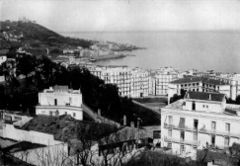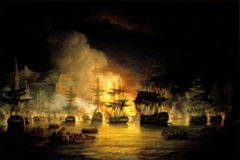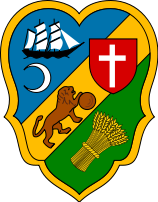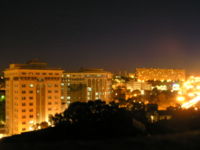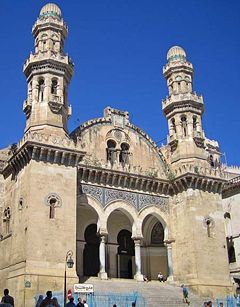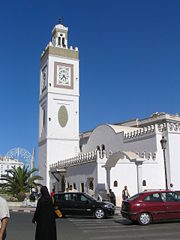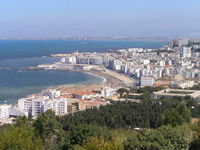Algiers
2008/9 Schools Wikipedia Selection. Related subjects: Africa; Cities
| Algiers الجزائر |
|||
|
|||
| Nickname: Algiers the White | |||
| Location of Algiers within Algeria | |||
| Coordinates: | |||
|---|---|---|---|
| Country | Algeria | ||
| Wilaya | Algiers Province | ||
| Re-founded | AD 944 | ||
| Government | |||
| - Wali ( Governor) | Mohamed Kebir Addou | ||
| Population (2005) | |||
| - City | 1,519,570 | ||
| - Urban | 2,029,936 | ||
| - Metro | 3,518,083 | ||
| Time zone | CET ( UTC+1) | ||
| Postal codes | 16000-16132 | ||
Algiers (Arabic: الجزائر, Standard Arabic: Al Jaza'ir IPA: [ɛlʤɛˈzɛːʔir], Algerian Arabic: Dzayer ([dzæjer] (From Berber pronunciation), Berber: ![]() , Ledzayer [ldzæjər], French: Alger [ɑlʒe]) is the capital and largest city of Algeria, and the second largest city in the Maghreb (behind Casablanca). According to the 2005 census, the population of the city proper was 1,519,570; for the urban area was 2,135,630; for the metropolitan area 3,518,083; and for Algiers Province as a whole 5,723,749 (2006). Thus the urban area of Greater Algiers is one of the largest in North Africa
, Ledzayer [ldzæjər], French: Alger [ɑlʒe]) is the capital and largest city of Algeria, and the second largest city in the Maghreb (behind Casablanca). According to the 2005 census, the population of the city proper was 1,519,570; for the urban area was 2,135,630; for the metropolitan area 3,518,083; and for Algiers Province as a whole 5,723,749 (2006). Thus the urban area of Greater Algiers is one of the largest in North Africa
Nicknamed El-Bahdja (البهجة) or Alger la Blanche ("Algiers the White") for the glistening white of its buildings as seen rising up from the sea, Algiers is situated on the west side of a bay of the Mediterranean Sea. The city name is derived from the Arabic word al-jazā’ir, which translates as the islands, referring to the four islands which lay off the city's coast until becoming part of the mainland in 1525. Al-jazā’ir is itself a truncated form of the city's older name jazā’ir banī mazghannā, "the islands of (the tribe) Bani Mazghanna", used by early medieval geographers such as al-Idrisi and Yaqut al-Hamawi. Algiers is the only Algerian city with an English name different from its French name.
The modern part of the city is built on the level ground by the seashore; the old part, the ancient city of the deys, climbs the steep hill behind the modern town and is crowned by the casbah or citadel, 400 feet (122 m) above the sea. The casbah and the two quays form a triangle.
History
A Phoenician commercial outpost called Ikosim which later developed into a small Roman town called Icosium existed on what is now the marine quarter of the city. The rue de la Marine follows the lines of what used to be a Roman street. Roman cemeteries existed near Bab-el-Oued and Bab Azoun. The city was given Latin rights by Vespasian. The bishops of Icosium are mentioned as late as the 5th century.
The present-day city was founded in 944 by Buluggin ibn Ziri, the founder of the Berber Zirid- Senhaja dynasty, which was overthrown by Roger II of Sicily in 1148, although the Zirids had already lost control of Algiers before the final fall of the dynasty. The city was occupied by the Almohades in 1159, and in the 13th century came under the dominion of the Abd-el-Wadid sultans of Tlemcen. Nominally part of the sultanate of Tlemcen, Algiers had a large measure of independence under amirs of its own due to Oran being the chief seaport and centre of power of the Abd-el-Wahid.
As early as 1302 the islet of Penon in front of Algiers harbour had been occupied by Spaniards. Thereafter, a considerable amount of trade began to flow between Algiers and Spain. However, Algiers continued to be of comparatively little importance until after the expulsion of the Moors from Spain, many of whom sought asylum in the city. In 1510, following their occupation of Oran and other towns on the coast of Africa, the Spaniards fortified the islet of Penon. In 1516, the amir of Algiers, Selim b. Teumi, invited the corsair brothers Aruj and Khair ad-Din Barbarossa to expel the Spaniards. Aruj came to Algiers, ordered the assassination of Selim, and seized the town. Khair ad-Din, succeeding Arouj after the latter was killed in battle against the Spaniards at Tlemcen, was the founder of the pashaluk, which subsequently became the beylik, of Algeria after formally inviting the Sultan to accept sovereignty over the territory and to annex Algiers to the Ottoman Empire.
Algiers from this time became the chief seat of the Barbary pirates. In October 1541, the King of Spain and Holy Roman Emperor Charles V sought to capture the city, but a storm destroyed a great number of his ships, and his army of some 30,000, chiefly made up of Spaniards, was defeated by the Algerians under their Pasha, Hassan. Formally part of the Ottoman Empire but essentially free from Ottoman control, starting in the 17th century Algiers turned to piracy and ransoming. Due to its location on the periphery of both the Ottoman and European economic spheres, and depending for its existence on a Mediterranean that was increasingly controlled by European shipping, backed by European navies, piracy became the primary economic activity. Repeated attempts were made by various nations to subdue the pirates that disturbed shipping in the western Mediterranean and engaged in slave raids as far north as Cornwall. The United States fought two wars (the First and Second Barbary Wars) over Algiers' attacks on shipping.
In 1816, the city was bombarded by a British squadron under Lord Exmouth (a descendant of Thomas Pellew, taken in an Algerian slave raid in 1715), assisted by Dutch men-of-war, destroying the corsair fleet harboured in Algiers.
The history of Algiers from 1830 to 1962 is bound to the larger history of Algeria and its relationship to France. On July 4, 1827, under the pretext of an affront to the French consul — whom the dey had hit with a fly-whisk when the counsul said the French government was not prepared to pay its large outstanding debts to two Algerian Jewish merchants — a French army under General de Bourmont attacked the city, which capitulated the following day. Algiers became a French colony.
In 1962, after a bloody independence struggle in which up to 1.5 million Algerians died at the hands of the French Army and the Algerian Front de Libération Nationale, Algeria finally gained its independence, with Algiers as its capital. Since then, despite losing its entire European or pied-noir population, the city has expanded massively. It now has about 3 million inhabitants, or 10 percent of Algeria's population — and its suburbs now cover most of the surrounding Metidja plain.
Having hosted the All-Africa Games in 1978, Algiers will again host the games in 2007. Algiers is also the "Capital of Arabic Culture" for 2007.
War of Algeria
Algiers also played a decisive part during the War of Algeria (1954-1962), in particular during the Battle of Algiers, during which the 10th Parachute Division of the French Army, starting on January 7, 1957, led attacks on the Algerian fighters for independence, on the orders of the Minister of Justice François Mitterrand, who authorized any means “to eliminate the insurrectionists”. Algiers remains marked by this battle characterized by merciless fighting between the Algerian forces resorting to attacks on the French colonists and the French Army carrying out a bloody repression, including the quasi-systematic use of torture against the protesters of the colonial order. Two such victims were the young professor of mathematics Maurice Audin and the nationalist leader Larbi Ben M'Hidi, honoured since by the municipality: principal arteries of the city bear their names. The demonstrations of May 13, 1958 during the crisis of May 1958 provoked the fall of the Fourth Republic in France, as well as the return of General de Gaulle to power.
Independence
Algeria achieved independence on July 5, 1962. Run by the military that had liberated it, Algiers became a member of Non-Aligned Movement during the Cold War. In October 1988, one year before the fall of the Berlin Wall, Algiers was the site of demonstrations demanding the end of the single party system and the creation of a real democracy baptized the “Spring of Algiers”. The demonstrators were repressed by the authorities (more than 300 dead), but the movement constituted a turning point in the political history of modern Algeria. In 1989, a new constitution was adopted that put an end to the reign of the single party and saw the creation of more than fifty political parties, as well as official freedom of the press.
Crisis of the 1990s
The city became the theatre of many political demonstrations of all descriptions until 1992. In 1991, a political entity dominated by religious conservatives called the Islamic Salvation Front engaged in a political test of wills with the authorities. In the 1992 elections for the Algerian National Assembly, the Islamists garnered a large amount of support in the first round, helped by a massive abstention from disillusioned Algerian voters by the of turn events. Fearing an eventual win by the Islamists, the army cancelled the election process, setting off a civil war between the State and armed religious conservatives which would last for a decade.
Algiers in the 21st century
Today, in 2007, Algiers is seeking to once again become an important African and Mediterranean capital, envisioning having a comparable level of infrastructure development to what it had in 1962 relative to other countries. Algiers is opening itself up to the world by hosting a variety of international conferences and events. This new openness has attracted the investment of a number of multinational companies in recent years, such as: Carrefour, Yves Rocher, and even Quick. However, many large infrastructure projects are struggling to be completed: the Algiers subway, the tramway, urban renewal projects, the creation of new urban centers on the periphery. The current infrastructure has not been able to keep up with Algiers' rapid growth.
Algiers is currently ranked lowest out of 132 capitals in the Economist Intellegince Unit's quality of life survey. The survey takes into consideration 40 different criteria divided into 5 categories: stability, health services, culture and environment, education, and the availability of basic services. Algiers was ranked lower than such cities as Karachi (Pakistan), Tripoli (Libya), Abidjan (Côte-d'Ivoire), and even Dhaka, the capital of Bangladesh. In 2005 the same survey ranked Algiers 125th out of 129 cities.
Bombings
2007 has brought mixed results for Algiers. On the positive side the city has been named the capital of "Arab culture" for 2007. On the negative side, a double bombing attack occurred on April 11 with one bomb targeting the government building housing the Prime Minister and the Minister of the Interior; and another bomb targeting the police station in Bab-Ezzouar. The attacks were claimed by an organization calling themselves the Maghreb branch of Al-Qaida.
On December 11, 2007, two car bombs exploded in the city of Algiers. One bomb targeted two United Nations buildings and the other targeted a government building housing the Supreme Court. The death toll is at least 62, with over two hundred injured in the attacks. However, only 26 remained hospitalized the following day. As of now, it is speculated that the attack was carried out by the Al Qaida cell within the city.
Indigenous terrorist groups have been actively operating in Algeria since around 2002. For accurate information on these groups, who could very well have been responsible, please follow this link to an article on the Islamic insurgency in Algeria.
Districts of Algiers
| Kasbah of Algiers* | |
|---|---|
| UNESCO World Heritage Site | |
| Type | Cultural |
| Criteria | ii, v |
| Reference | 565 |
| Region† | Arab States |
| Inscription history | |
| Inscription | 1992 (16th Session) |
| * Name as inscribed on World Heritage List. † Region as classified by UNESCO. |
|
- The Casbah (of Al Qasbah , “the Citadel”), Ier District of Algiers: called Al-Djazaïr Al Mahroussa (“Well Kept Algiers”), it is founded on the ruins of old Icosium. It is a small city which, built on a hill, goes down towards the sea, divided in two: the High city and the Low city. One finds there masonries and mosques of the 17th century; Ketchaoua mosque (built in 1794 by the Dey Baba Hassan) flanked by two minarets, mosque el Djedid (built in 1660, at the time of Turkish regency) with its large finished ovoid cupola points some and its four coupolettes, mosque El Kébir (oldest of the mosques, it was built by almoravide Youssef Ibn Tachfin and rebuilt later in 1794), mosque Ali Betchnin (Raïs, 1623), Dar Aziza, palate of Jénina. In the Kasbah, there are also labyrinths of lanes and houses that are very picturesque; and if one gets lost there, it is enough to go down again towards the sea to reposition oneself.
- Bab El Oued : popular district which extends from the Casbah beyond "the gate of the river". It is the district more chouchouté and more liked of all the districts of the capital. Famous for its place “the three clocks” and for its “market Triplet”, it is also a district of workshops and manufactures.
- Edge of sea : from 1840, the architects Pierre-August Guiauchain and Frederic Chassériau designed new buildings apart from the Kasbah, town hall, law courts, buildings, theatre, palace of the Governor, casino... to form an elegant walk bordered by arcades which is the boulevard today Che Guevara (ex-boulevard of Republic).
- Kouba ( will daira of Hussein-dey): Kouba is an old village which was absorbed by the expansion of the town of Algiers. Of village, Kouba quickly developed under the French colonial era then continued growing due to formidable demographic expansion that Algiers knew after the independence of Algeria in 1962. It is today a district of Algiers which is largely made up of houses, villas and buildings not exceeding five stories.
- El Harrach, according to the name of the river which crosses this district. The mouth of this river played a very important part in the catch of Algiers and the Dogvane, this rock opposite Algiers occupied by the Spaniards. Indeed, at the beginning of the 16th century, with the call of the one of the dignitaries of Algiers autochthones who saw the progressive loss of the authority of the city in front of the occupation of the Dogvane by the Spaniards, one of the Barberousse brothers hid his fleet there before taking Algiers by surprised by the south-eastern side. This district of Algiers will be named Square-House by the French, who will make of it the industrial park of the city. Thus, during colonization, as well El-Harrach as Hussein-Dey will be satellite towns of Algiers where Algerian autochthones more or less will cohabit with French, but in clearly separate zones. This city will be a residential district for an easy layer of French, but a true ghetto for the Algerians, especially those pushed by the rural migration. El-Harrach was also a city which wrote a large page of sporting history with boxes and it football. After independence, El-Harrach will become gradually a district of Algiers, and later on chief town of Daira with a new cutting in districts, like Mohammadia, Belfort, Bellevue, the Park, Wadi-Smar, Five-Houses, the dunes, theMaritime ones, Beaulieu, etc.
- The communes of Hydra, Ben Aknoun, El-Biar and Bouzareah form what the inhabitants of Algiers call the heights of Algiers. These communes, sometimes famous knacks, shelter the majority of the foreign embassies of Algiers, of many ministries and university centers, which makes it one of the administrative and policy centers of the country.
- The street Didouche Mourade Ex Rue Michelet is located in the 3rd district Of Algiers. It extends from the Grande Post office to the Heights of Algiers. It crosses in particular the place Audin , the Faculty of Algiers , The Crowned Heart and the park of Galland . It is bordered by smart stores and restaurants along most of its length. It is regarded as the heart of the capital.
Local architecture
There are many public buildings of interest, including the whole Kasbah quarter, Martyrs Square (Sahat ech-Chouhada ساحة الشهداء), the government offices (formerly the British consulate), the "Grand", "New", and Ketchaoua Mosques, the Roman Catholic cathedral of Notre Dame d'Afrique, the Bardo Museum (a former Turkish mansion), the old Bibliotheque Nationale d'Alger — a Turkish palace built in 1799–1800 — and the new National Library, built in a style reminiscent of the British Library.
The main building in the Kasbah was begun in 1516 on the site of an older building, and served as the palace of the deys until the French conquest. A road has been cut through the centre of the building, the mosque turned into barracks, and the hall of audience allowed to fall into ruin. There still remain a minaret and some marble arches and columns. Traces exist of the vaults in which were stored the treasures of the dey.
The Great Mosque (Jamaa-el-Kebir الجامع الكبير) is the oldest mosque in Algiers. It was first built by Yusuf ibn Tashfin, but reconstructed many times. The pulpit ( minbar منبر) bears an inscription showing that the building existed in 1097. The minaret was built by the sultan of Tlemcen, in 1324. The interior of the mosque is square and is divided into aisles by columns joined by Moorish arches.
The New Mosque (Jamaa-el-Jedid الجامع الجديد), dating from the 17th century, is in the form of a Greek cross, surmounted by a large white cupola, with four small cupolas at the corners. The minaret is 90 feet (27 m) high. The interior resembles that of the Grand Mosque.
The church of the Holy Trinity (built in 1870) stands at the southern end of the rue d'Isly near the site of the demolished Fort Bab Azoun باب عزون. The interior is richly decorated with various coloured marbles. Many of these marbles contain memorial inscriptions relating to the English residents (voluntary and involuntary) of Algiers from the time of John Tipton, British consul in 1580. One tablet records that in 1631 two Algerine pirate crews landed in Ireland, sacked Baltimore.
The Ketchaoua mosque (Djamaa Ketchaoua جامع كتشاوة), at the foot of the Casbah, was before independence in 1962 the cathedral of St Philippe, itself made in 1845 from a mosque dating from 1612. The principal entrance, reached by a flight of 23 steps, is ornamented with a portico supported by four black-veined marble columns. The roof of the nave is of Moorish plaster work. It rests on a series of arcades supported by white marble columns. Several of these columns belonged to the original mosque. In one of the chapels was a tomb containing the bones of San Geronimo. The building seems a curious blend of Moorish and Byzantine styles.
Algiers possesses a college with schools of law, medicine, science and letters. The college buildings are large and handsome. The Bardo museum holds some of the ancient sculptures and mosaics discovered in Algeria, together with medals and Algerian money. The port of Algiers is sheltered from all winds. There are two harbours, both artificial — the old or northern harbour and the southern or Agha harbour. The northern harbour covers an area of 235 acres (95 ha). An opening in the south jetty affords an entrance into Agha harbour, constructed in Agha Bay. Agha harbour has also an independent entrance on its southern side. The inner harbour was begun in 1518 by Khair-ad-Din Barbarossa (see History, below), who, to accommodated his pirate vessels, caused the island on which was Fort Penon to be connected with the mainland by a mole. The lighthouse which occupies the site of Fort Penon was built in 1544.
Algiers was a walled city from the time of the deys until the close of the 19th century. The French, after their occupation of the city (1830), built a rampart, parapet and ditch, with two terminal forts, Bab Azoun باب عزون to the south and Bab-el-Oued باب الواد to the north. The forts and part of the ramparts were demolished at the beginning of the 20th century, when a line of forts occupying the heights of Bouzareah بوزريعة (at an elevation of 1,300 feet (396 m) above the sea) took their place. Notre-Dame d'Afrique, a church built (1858–1872) in a mixture of the Roman and Byzantine styles, is conspicuously situated, overlooking the sea, on the shoulder of the Bouzareah hills, 2 miles (3.2 km) to the north of the city. Above the altar is a statue of the Virgin depicted as a black woman. The church also contains a solid silver statue of the archangel Michael, belonging to the confraternity of Neapolitan fishermen.
Villa Abd-el-Tif, former residence of the dey, was used during the French period, to accommodate French artists, chiefly painters, and winners of the Abd-el-Tif prize, among whom Maurice Boitel, for a while of two years. Nowadays, Algerian artists are back in the villa's studios.
Monuments
- Notre Dame d'Afrique , accessible by one cable car, is one of its most outstanding monuments: located in the district of Z' will ghara, the basilica was built around 1858.
- Monument des Martyrs ( Maquam E' chahid ): an iconic concrete monument commemorating the Algerian war for independence. The monument was opened in 1982 on the 20th anniversary of Algeria's independence. It is fashioned in the shape of three standing palm leaves which shelter the "Eternal Flame" beneath. At the edge of each palm leaf stands a statue of a soldier, each representing a stage of Algeria's struggle.
- The El Jedid mosque at the Places des Martyrs near the port.
- Place of the Emir Abdelkader (ex-place Bugeaud): in memory of the famous emir Abd El-Kader, resistant during conquête of Algeria.
- Grand Post Office (1910, by Voinot and Tondoire): construction of the néo-Moorish type which is in full centre town of Algiers.
- Garden of Test ( El-Hamma ): located has Is of Algiers, it extends on a surface from 80 hectares (198 acres). It was created in 1832 by A. Hardy. Exotic plants and gardens there are found.
- Villa Abd-el-Hair , with the top of the Garden of test, one of the old residences of the dey, where until 1962, were placed the artists prizes winner of Price Abd-el-Hair, and in particular Maurice Boitel and Andre Hamburg.
- Citadel .
- Riadh El-Feth (shopping centre and art gallery).
- Ketchoua Mosque (This mosque became the Saint-Philippe cathedral during colonization before becoming again a mosque).
- National Library , is in the district of El HAMMA. Elle has an architecture modèrne and marries the decoration perfectly.
- The Great Mosque of Algiers at he Rue de la Marine. It is the oldest mosque of Algiers and was built during the reign of the Almoravid sultan Yusuf ibn Tashfin.
Demographics
Algiers has a population of 2,072,993 (2007 estimates).
| Year | Population |
|---|---|
| 1977 (Census) | 1,353,826 |
| 1987 (Census) | 1,507,241 |
| 1998 (Census) | 1,519,570 |
| 2007 (Estimate) | 2,072,993 |
Economy
Algiers is an important economic, commercial and financial centre, with in particular a stock exchange with a capitalisation of 60 billion euros. The port of Algiers is also the most important of West Africa. The city has the highest cost of living of any city in North Africa, as well as the 50th highest worldwide, as of March 2007, having gained one position comparet to the previous year. Mohamed Ben Ali El Abbar, president of the Council d administration of the emirate group EMAAR, presented five "megaprojects" to Algerian President Abdelaziz Bouteflika, during a ceremony which took place Saturday, July 15 with the Palate of the People of Algiers. The projects will transform the city of Algiers and its surroundings by equipping them with a retail area, and restoration and leisure facilities. The first project will concentrate on the reorganization and the development of the infrastructures of the railway station "Aga" located in the downtown area. Ultramodern, the station, intended to accommodate more than 80.000 passengers per day, will become a center of circulation in the heart of the grid system, surrounded by commercial offices and buildings and hotels intended for travelers in transit. A shopping centre and three high-rise office buildings rising with the top of the commercial zone will accompany the project. The second project will relate to the bay of Algiers and aims to revitalize the sea front. The development of the 44 km (27 mi) sea front will include marinas, channels, luxury hotels, offices, apartments of great standing, luxury stores and leisure amenities. A crescent-shaped peninsula will be set up on the open sea. The project of the bay of Algiers will also comprise six small islands, of which four of round form, connected to each other by bridges and marinas and will include tourist and residential complexes. The third project will relate to restructuring an area of Algiers, qualified by the originators of the project of "city of wellness". El Abbar indicated to the journalists that the complex would be "agréable for all those which will want to combine tourism and wellbeing or tourism and relaxation". The complex will include a university, a research centre and a medical centre. It should also include a hospital complex, a care, centre, a hotel zone, an urban centre and a thermal spa with villas and apartments. The university will include a medical school and a school for care male nurses which will be able to accommodate 500 students. The university campus will have the possibility of seeing setting up broad ranges of buildings of research laboratories and residences. Another project relates to technological implantation of a campus in Sidi Abdellah, 25 km (16 mi) south-east from Algiers. This 90 hectares (222 acres) site will include shopping centres, residential zones with high standard apartments and a golf course surrounded by villas and hotels. Two other residential zones, including 1.800 apartments and 40 high standard villas, will be built on the surrounding hills. The fifth project is that of the tourist complex Colonel Abbès, which will be located 25 km (16 mi) west from Algiers. This complex will include several retail zones, meetingplaces, and residential zones composed of apartments and villas with views of the sea.
Tourist installations
Some 20 km (12 mi) to the west of Algiers are such seaside resorts as Sidi Fredj (ex-Sidi Ferruch), Palm Beach, Douaouda, Zéralda, and the Club of the Pines (residence of State); there are tourist complexes, Algerian and other restaurants, souvenir shops, supervised beaches, and other amenities. The city is also equipped with important hotel complexes such as the hotel Hilton, El-Aurassi or El Djazair. Algiers also has the first water park in the country. Located ten minutes from the city to the East, Kiffan Club extends over a surface of 2 hectares (5 acres). With a large adult pool, several child pools, as well as large toboggans, the site includes several points of restoration. With dimensions is the Karting Escape, which opened its doors in 2005, with a long track 700 metres (2,300 ft) and three different categories of karts. Aquafortland http://www.aquafortland.com supplements this decoration with a ludic swimming pool spread out over 1.5 hectares (4 acres), and with all the conveniences necessary for the wellbeing of the customer. The tourism of Algiers is in ascendance but is not as developed as that of a larger city of Morocco or of Tunisia.
Public transport
- ETUSA (urban and suburban bus transportation for Algiers) operates bus service in Algiers and the surrounding suburbs. 54 lines are currently operating, with service from 5:30 a.m. to 12:45 a.m.
- SNTF (national railroad company) operates commuter-rail lines connecting the capital to the surrounding suburbs.
- Algiers Metro open in 2008.
- Houari Boumedienne Airport is located 20 km (12 mi) from the city. The airport serves many European cities, West Africa, the Middle East and North America (Montreal). On July 5, 2006 a new international air terminal was opened for service. The terminal is managed by Aéroports de Paris.
Quinquennial projects of the wilaya of Algiers
- To make up the enormous deficit which the city of Algiers as regards transport knows, this one will be equipped with one tram which will connect it downtown area to Dergana (operational in 2009), of a line of subway Tafourah-Large Harrach Post office-El (operational in 2008) and several lines RER Algiers-Aga-Thenia, Algiers-Aga-Elafroun, Algiers-Aga-Zeralda. Be added to all this the reorganization of Etusa (Haulage company Urbain and Suburbain of Algiers), the realization of three new cable cars from here 2009, the rehabilitation of four what exists as well as the refitting of roadway system. It is also a question of the restoration of the station of Algiers (Aga) to accommodate the future line High-speed rail Annaba-Algiers-Oran.
- Most important, c'est the d'Emaar project which discusses with the government on the rehabilitation and modernization d'une good part of the bay d'Alger. An investment of more than 28 billion dollars spread out over several years which will change l'image completely l'est capital, with buildings and hotels high standing, a city of medicine.
- In addition, in response to the increase always increasing in the automobile park, and parallel to the installation of way S and roundabouts, of échangeurs and of the sections of motorway were built right now, and others are in the course of construction in order to improve the traffic in the metropolis.
- One of the most ambitious projects is the installation of bay of Algiers which will consist of a mall of two kilometers, it Marriots hotel Algiers, spaces of relaxation, a business district a with shopping centre, and finally, the future large one mosque of Algiers. This mosque will be the second largest in the world with a capacity of reception of more than 80,000 faithful. A school - at the same time école and school of science the S - y will be attached, bordered by parks.
- Construction of two seaside resorts on the of Algiers littoral.
- Park of the high winds which is located at the west of Algiers: it will be largest in the world; many species of trees and plants will be planted there.
- The new town of Sidi Abdellah which will include/understand a technological pole and of research, like residences.
- Within the framework of the project of a million residences that the state launched, Algiers will benefit from additional residences to the program of 2001 and 2004, in order to fight effectively against the current housing shortage.
Sports
Algiers is the largest sporting pole of Algeria. Cash clubs in the whole of the disciplines, and which conquered many national and international titles, it also counts an enormous sporting complex (Complex of OCO - Mohamed Boudiaf), which gathers the Olympic stage of July 5 (of a capacity of 80,000 places), a stage annexes for athletics, an Olympic swimming pool, a room multisports (the Cupola), a golf 18 holes, and several courts of tennis.
Algiers already accommodated the following sporting events (not-exhaustive list):
- Mediterranean Games 1975.
- All-Africa Games 1978, 2007.
- African Cup of Nations 1990.
- African Handball Nations Championship 1989, 2001.
- Pan Arab Games 2004.
- FIBA Africa Championship 2005.
- Men's U19 World Championship 2005.
Football clubs
Principal clubs of association football of the city (having already evolved/moved in Division 1):
- MC Alger
- USM Alger
- CR Belouizdad
- NA Hussein Dey
- Paradou AC
- USM El Harrach
- RC Kouba
- OMR El Annasser
- DNC Algiers (now defunct)
Sister relationships
Algiers has sister relationships with a number of cities worldwide:
In addition, many of the wards and cities within Algiers maintain sister-city relationships with other foreign cities.
Films about Algiers
- The Battle of Algiers, 1966, directed by Gillo Pontecorvo;
- Tahya ya Didou, Alger Insolite, 1970, Mohammed Zinet;
- Bab City El-Wadi, 1994, directed by Merzak Allouache;
- Viva aldjery, 2003, directed by Nadir Moknèche, with Biyouna and Lubna Azabal;
- Bab el Web, 2004, directed by Merzak Allouache, with Samy Naceri, Julie Gayet, Faudel;
- It was once in the wadi, 2005, directed by Djamel Bensalah;
- Beur, White, Red, 2005, directed by Mahmoud Zemmouri.
- Delice Paloma, 2007, directed by Nadir Moknèche, with Biyouna and Nadia Kaci.


